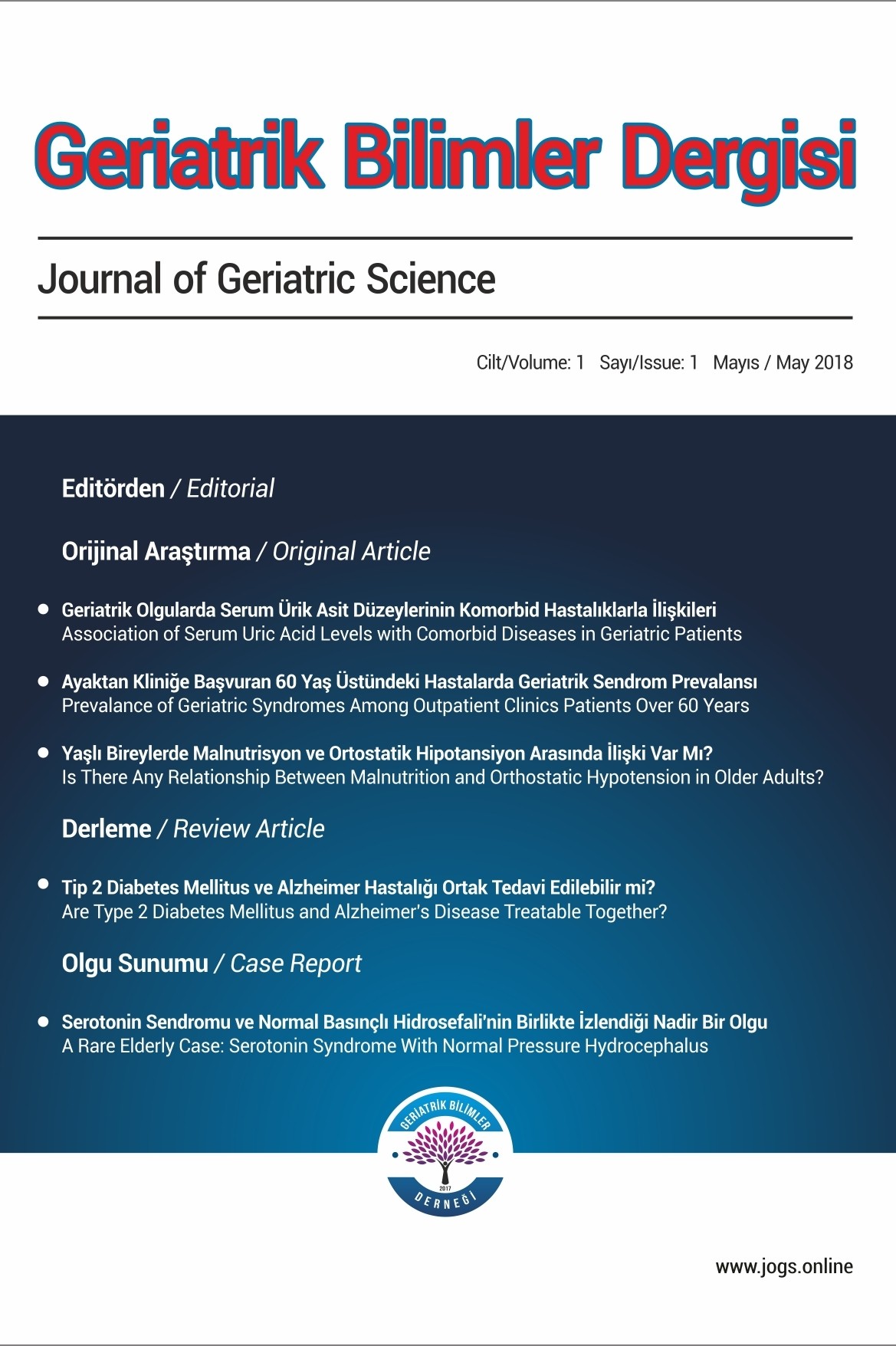Geriatrik Sendromlarda Düşme Sıklığı
Düşme, geriatrik sendrom, polifarmasi, komorbidite, yaşlı
The Frequency of Fall in Geriatric Syndromes
Fall, geriatric syndrome, polypharmacy, comorbidity, older adult,
___
- Referans 1. Kaya D, Koçyiğit SE, Dokuzlar Ö, ve ark., Geriatri Poliklinik Olgularında Geriatrik Sendromlar: 1048 olgunun analizi, Dokuz Eylül Üniversitesi Tıp Fakültesi, Geriatri Bilim Dalı, Yaşlanan Beyin ve Demans Ünitesi, İzmir, Türkiye, Ege Journal of Medicine; 2018;57(1):31-35
- Referans 2. Soysal P, Işık AT. Geriatri Pratiğinde Geriatrik Sendromlar. Editörler; Soysal P, Işık AT. US Akademi. 2018, 161-171
- Referans 3. WHO Global Report on Falls Prevention in Older Age, 2007
- Referans 4. Stephen R. Lord, Catherine S, Hylton B. Mens Falls in Older People: Epidemiology, Risk Factors and Strategies for Prevention. Age Ageing. 2006; 35 Suppl 2:ii37-ii41.
- Referans 5. Catharine R. Gale, Cyrus Cooper, Avan Aihie S, Prevalence and risk factors for falls in older men and women: The English Longitudinal Study of Ageing, Age and Ageing, Volume 45, Issue 6, 2 November 2016, Pages 789–794
- Referans 6. Tinetti ME, Speechley M, Ginter SF. Risk factors for falls among elderly persons living in the community. N Engl J Med. 1988;319:1701–7.
- Referans 7. O’Loughlin JL, Robitaille Y, Boivin JF, et al. Incidence of and risk factors for falls and injurious falls among the community-dwelling elderly. Am J Epidemiol 1993;137:342–54.
- Referans 8. G. Ziere, J. P. Dieleman, A. Hofman, et al. Polypharmacy and falls in the middle age and elderly population, Br J Clin Pharmacol. 2006 Feb;61(2):218-23 DOI:10.1111/j.1365-2125.2005.02543.x
- Referans 9. Dhalwani NN, Fahami R, Sathanapally H, et al. Association between polypharmacy and falls in older adults: a longitudinal study from England, 2017 Oct 16;7(10):e016358. doi: 10.1136/bmjopen-2017-016358
- Referans 10. Hunskaar S, Arnold E, Burgio K et al. Epidemiology and natural history of urinary incontinence. In: Abrams P, Khoury S, Wein A, eds. Incontinence. Plymbridge, UK: Health Publication Ltd, 1999, pp 197-226.
- Referans 11. Luukinen H, Koski K, Hiltunen L, et al. Incidence rate of falls in an aged population in northern Finland. J Clin Epidemiol 1994;47:843- 850.
- Referans 12. Brown JS, Vittinghoff E , Wyman JF et al. Urinary Incontinence: Does it Increase Risk for Falls and Fractures?, J Am Geriatr Soc. 2000; 48:721–725.
- Referans 13. Byoung-Jin Jeon, OT, The Effects of Obesity on Fall Efficacy in Elderly People, J. Phys. Ther. Sci. 25: 1485–1489, 2013
- Yayın Aralığı: Yılda 3 Sayı
- Başlangıç: 2018
- Yayıncı: Geriatrik Bilimler Derneği
Geriatrik Olgularda Görülen Kırıklar
Türkiye'de Gerontoloji Atlası: Yaşlı Yoksulluğu ve Yalnızlık Üzerine Bulgular
İsmail TUFAN, Aslı KILAVUZ, Özlem ÖZGÜR, F.Sıla AYAN, Faruk Yaşar GÜRDAL, Berkay ENGİN
Geriatrik Sendromlarda Düşme Sıklığı
Neziha ULUSOYLAR, Fatma Sena DOST GÜNAY, Özge DOKUZLAR, Saadet KOÇ OKUDUR
Postmenopozal Yaşlıların Beslenme Durumunun Değerlendirilmesi
Ayşe Hümeyra İSLAMOĞLU, Muazzez GARİPAĞAOĞLU, Havvanur YOLDAŞ İLKTAÇ, Fatma Esra GÜNEŞ
Uzman Görüşü: Yaşlılarda Metformin Kullanımı ve B12 Vitamin Eksikliği
